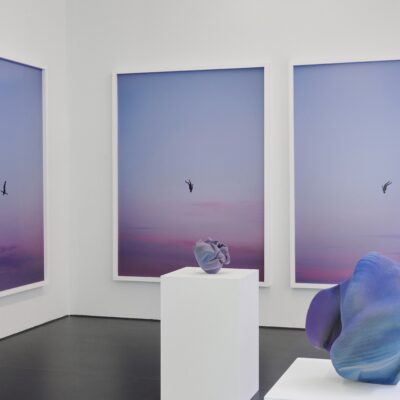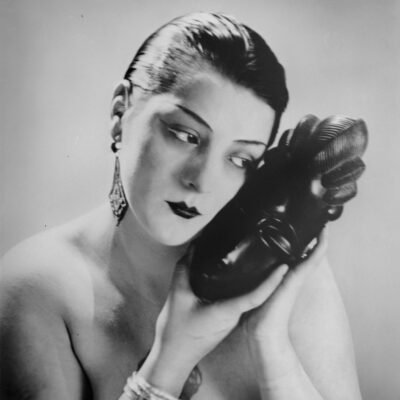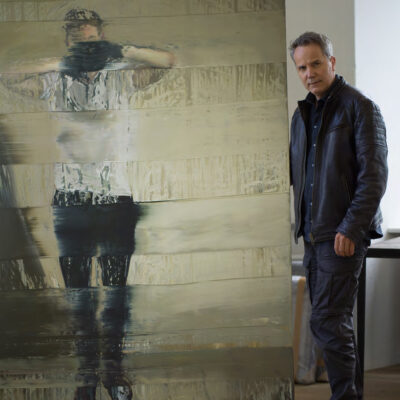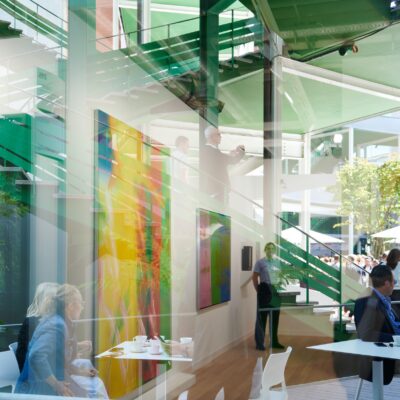This review first appeared in Philosophical Practice, Volume 17.2, July 2022, and is republished by permission of the American Philosophical Practitioners Association. https://appa.edu
The works of German-Egyptian sculptor Dr. Gindi, who launched her public career as an artist fairly recently, are meeting with great acclaim in fine arts circles across Europe, and well beyond. There are always many reasons for success, and one of several that arise in Dr. Gindi’s case is her gift for imbuing her sculptures with philosophical meanings, if not voices. And just in case a beholder does not quite discern the sotto voce of vocal cords cast in bronze, Dr. Gindi is well-prepared to articulate what her creations are saying. In numerous articles and interviews, she conveys the distinct impression that she is not so much a sculptor who waxes philosophical about her work; rather, a philosopher who enlists the medium of sculpture to express her concerns about the human condition, to depict its current and perennial challenges, and to reveal her aspirations for its amelioration if not transcendence. Thus, in Dr. Gindi’s capable hands—both literally and figuratively—sculpting becomes a form of philosophical practice.
Before looking at some examples of her work, and the positions they champion with respect to influential figures and phases in the history of philosophical ideas and their practice, it is relevant to remind ourselves that significant pieces of art are not merely objects at which tourists gawk in museums, nor occasions for connoisseurs to posture in galleries, nor pretexts for critics to vent their spleens, nor focal points for scholars to exercise exegetic overdrive. Whether bartered for a loaf of bread yesterday, or auctioned for a king’s ransom tomorrow, significant art always embodies a theme, a moral, or a narrative that emanates from the artist’s internalization of personal experience in and of the world. Such art invites audiences to partake of said experience, ultimately evoking kindred conceptions and emotions in them as well. Significant art is both a medium that allows the artist to bare her soul and wear her heart on her sleeve and at the same time a mirror that reveals to viewers something quintessential about themselves as well, something that relates and resonates, in elemental dimensions, to their own humanity. Dr. Gindi herself espouses this view: “I believe that artworks should not be created for museums alone, but rather for the profound interest of the people.”1
An example from the ancient world is afforded by Plato himself. Notwithstanding his mistrust of poetry among other volatile arts that could inflame emotions and incite mobs, one of Plato’s most enduring inspirations is his Allegory of the Cave, a work of metaphorical art rather than rigorous deduction. Yet this allegory speaks to generation after generation of readers, across centuries and cultures, because it reflects something vital and apparently universal about the human condition.
Now down to cases: one of Dr. Gindi’s foremost bones of contention is with René Descartes. She is self-described as “non-Cartesian.”2 She rejects his substance dualism in favor of a holistic and organic ontology that seeks to integrate the noetic and the substantial—reminiscent of non-dualistic Vedic schools. A medical doctor as well as a graduate of the Florence Academy of Art, she is well-qualified to be appalled at deleterious effects of dissociating body from mind, and emotions from conceptions. Beginning with estrangement from self, this road leads to man’s estrangement from nature, and thence to his despoilment of the natural world. Dr. Gindi’s art is partly devoted to mending this frayed fabric. “We cannot subjugate nature, as we are part of it,” she observes, in an Old-World voice that harmonizes with New England Transcendentalism. Ralph Waldo Emerson had opined in the 19th century: “The reason why the world lacks unity, and lies broken and in heaps, is, because man is disunited with himself.”3 To help remedy this condition, Dr. Gindi explains “I am sculpting at the tattered ends of nature.”4
While explicitly fingering Cartesian dualism’s overemphasis of rationalism and neglect of embodied sensory experience as roots of humanity’s spiraling spiritual bankruptcy, Dr. Gindi implicitly identifies Baconian empiricism as Descartes’s elder accomplice in man’s relentless crime-spree against the biosphere. For it was Francis Bacon who drove a pre-Cartesian wedge between man and nature, robbing us of our intimate connection with the natural world.5 Descartes was merely the “getaway driver” in this robbery. Indeed, as neuroscientist Antonio Damasio detailed to a broad readership in his 1994 classic Descartes’ Error, the experience of emotion is essential to the exercise of individual rationality and normal social behavior alike.6 Purely Cartesian “brains in vats” are capable of neither, while Baconian attempts to “subjugate” nature are doomed only to diminish and impoverish, if not vanquish, our own humanity.
Dr. Gindi vividly depicts her re-integrative remedy to this double-edged sword—man’s ruptured existence, dissociated from both self and nature—in a sculpture titled “The Horticulturist.” (figures 1 and 2). Rejecting the rigidity of Plato’s idealized mimetic realism in favor of extramental reality’s incessant flux of transformative plasticity, she illustrates a union of the naturalist with the natural world, a holistic hybridization that also entails distinctively non-Aristotelian logic: it is neither one, nor the other, nor both, nor neither. This “finished” work is thus a snapshot in bronze of a perpetual work-in-progress; not some idée fixe but rather (harking back to Heraclitus7) a becoming. In the artist’s own words, “He becomes one with his objects of love. Is he still a human or already trans- forming into a plant? The Horticulturist is not an illustration of nature. He is nature.”8
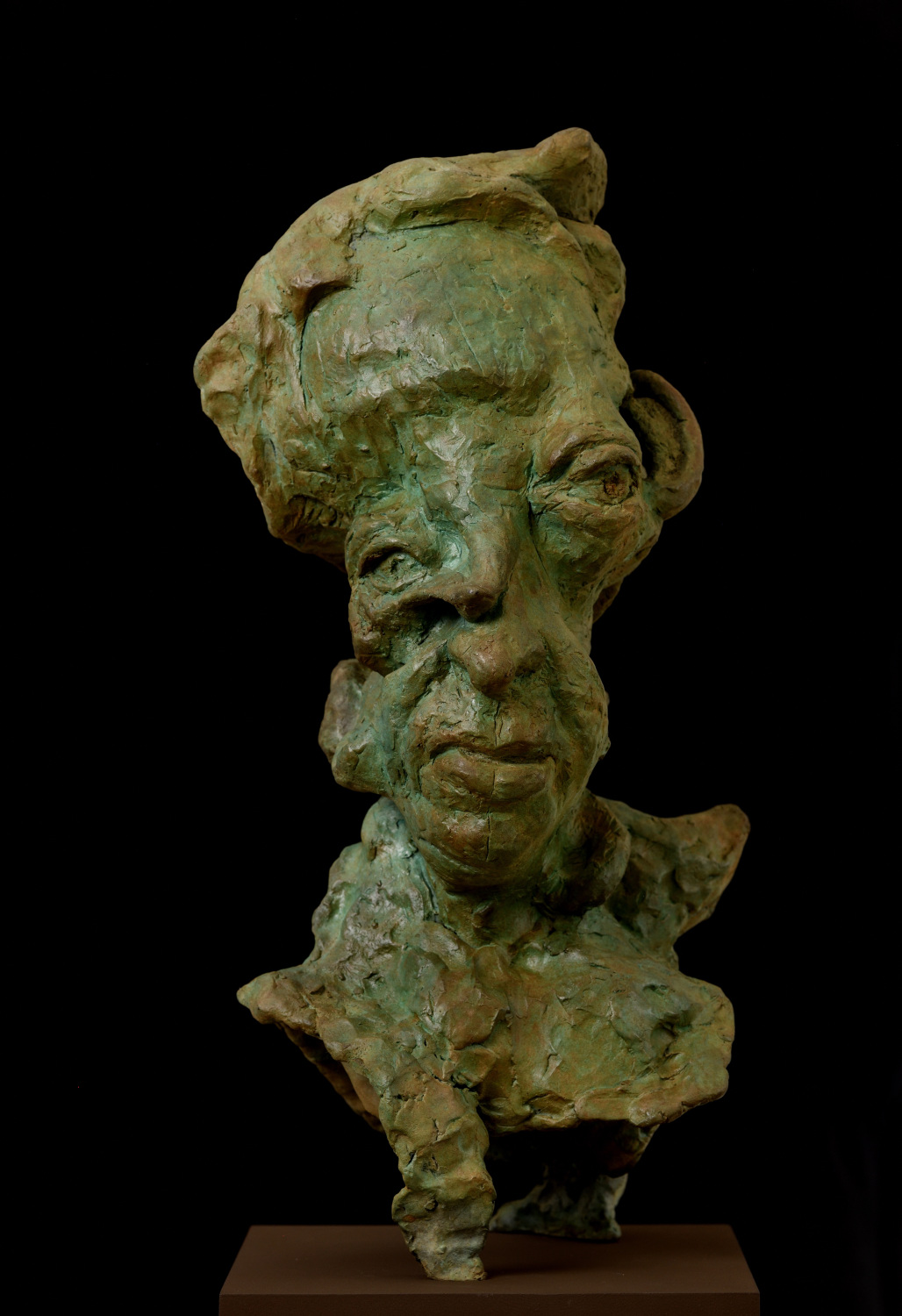
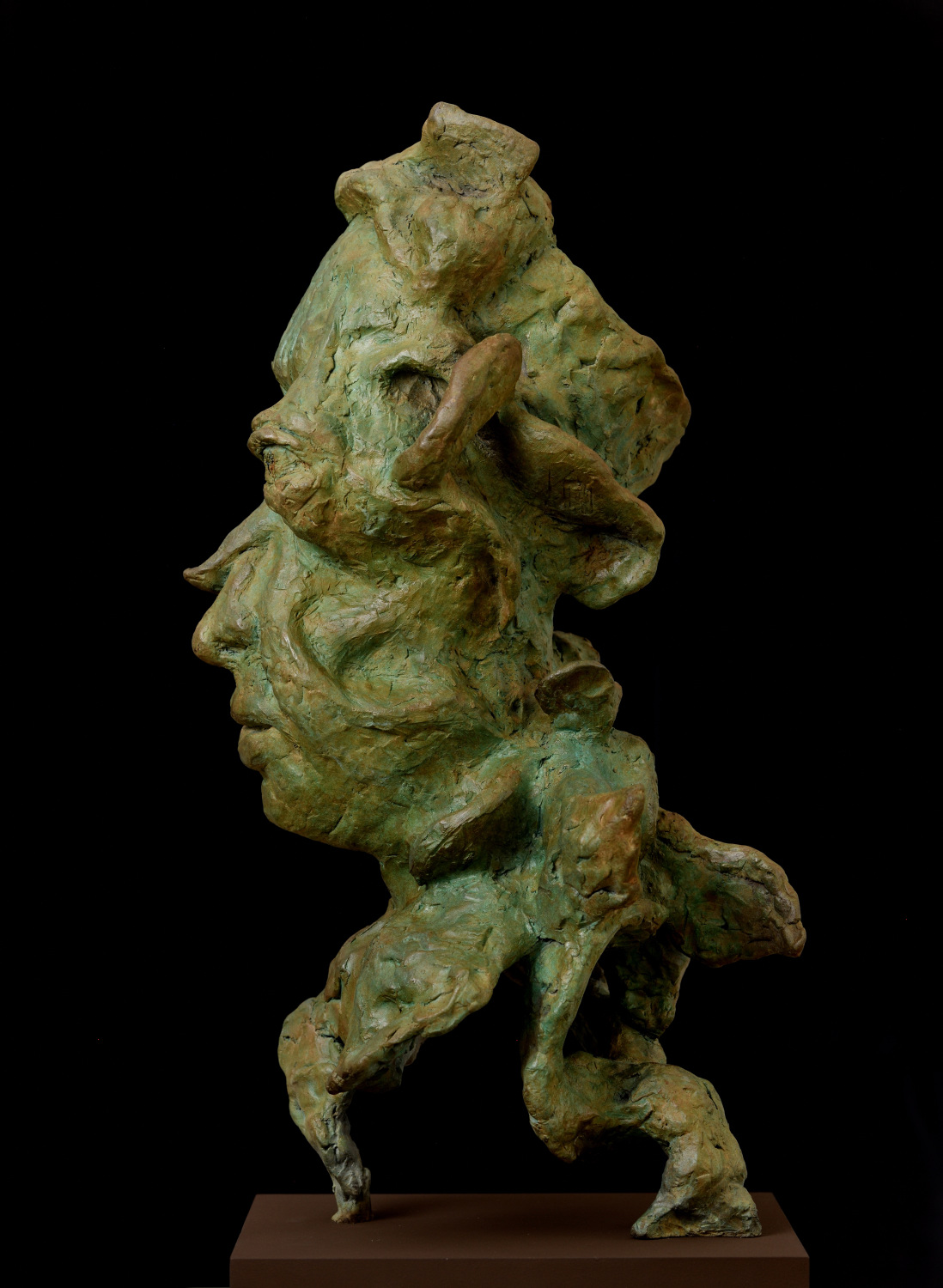
When it comes to human nature, emotions play undeniably pivotal roles along two parallel axes of being: the internal (vis-à-vis self), and the external (vis-à-vis others). Internally, our identities—memories of the past, experiences of the present, anticipations of the future—are ineluctably conditioned by a spectrum of emotions. Externally, our ways of interacting with others—whether in familial, social, cultural, political, or spiritual contexts—are similarly shaped if not governed by that same pervasive emotional spectrum.
A recurrent challenge to humanity throughout the ages is to confront and cope with our most powerful emotions, to express the destructive ones constructively, and to transform their most detrimental aspects into beneficial ones. Centuries of philosophical and artistic practices alike have demonstrated their efficacy in catalyzing such transformations, and Dr. Gindi is no stranger to this process. In a series called “Fractured Reality” she explores emotions such as fear, shame, and terror, which are surely primal not only since the inception of human existence, but also inherent and observable among extant lines of our primate forebears, e.g. the great apes.9 Sociobiologists and evolutionary psychologists would remind us, via standard neo-Darwinian retrodiction, that such anciently-rooted emotions must have possessed immense survival value, or else they would not have been so strongly favored by natural selection.
While that retrodiction may have rung true during our first quarter of a million years as a species, when we dispersed planet-wide and subsisted in small hunting-and-gathering bands, such emo- tions did not always or necessarily conduce to our flourishing once we crossed the Rubicon of the late Neolithic revolution, and began to congregate in ever-larger, more-or-less permanent settle- ments. “Civilized” man suffers from numerous counter-productive after-effects of natural selection that might be termed “failures of success”, among which imaginary or other unfounded fears are conspicuously deleterious to one’s well-being, and inhibitive of one’s full flourishing, since the pure survival instincts from which they arise are no longer necessary—however formerly vital—to one’s quotidian life in modern contexts.
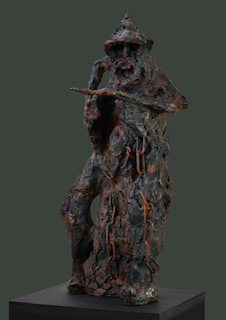


Dr. Gindi is well-aware of this phenomenon, and describes it as follows:
I get a sense of fear lurking just beneath us. And I would go so far to say that fear can pre- vent us from leading a normal life. The feeling of fear sometimes stems from real dangers, but it mostly originates from imagined threats.10
This dilemma—distinguishing between real versus imaginary threats—is currently being played out on a daily basis, and globally, as humanity endeavors to extricate itself not only from the fearful jaws of Covid-19, but also from the debilitating lock-downs and other restrictions imposed by fear of contagion. Even governments of the formerly freest democracies have waxed Machiavellian in their use of fear as a mechanism of population control.
Even if humanity returns to a “new normal”, or perhaps more accurately to a “new abnormal”, Dr. Gindi waxes decisively Hobbesian on our perennial predicament:
Human life seems to be solitary and nasty as everyone is at odds with everyone else, we permanently imagine hypothetical threats from others.11
Shame as well as fear appear ubiquitous among humans, spanning vast inter-cultural chasms widened by diverging written traditions and social mores alike. Whether grounded in a catastrophic loss of innocence (as cemented into the Judeo-Christian tradition by the myth of Eden), or in an irreversible loss of “face” (to be averted at all costs in Confucian cultures), or in a generic loss of one’s fundamental sense of dignity and valuation by others (as described in Dr. Gindi’s own “agnostic version”12), shame is universal in our species.
Perhaps deeper than both fear and shame, terror lurks closer to the existential root of being. Horror stories did not begin with Edgar Allen Poe. Small children and apparently even babies experience “night terrors”, even in the absence of external precipitating causes such as terrifying experiences during waking life. Among art therapy’s benefits is its potential to facilitate the auto-exorcism of our “home-made” demons, by fashioning cages for them. These cages are none other than works of art, rendered in any medium whatsoever.
Here, for example, is a watercolor painted by a two-year-old in a normal daycare setting. Children of this tender age are not capable of drawing realistic figures of any kind. Yet a significant number of adults or older children who are invited to surmise what this painting suggests perceive precisely the same thing. Look at it yourself for a moment, before reading on, and see whether it suggests anything to you:
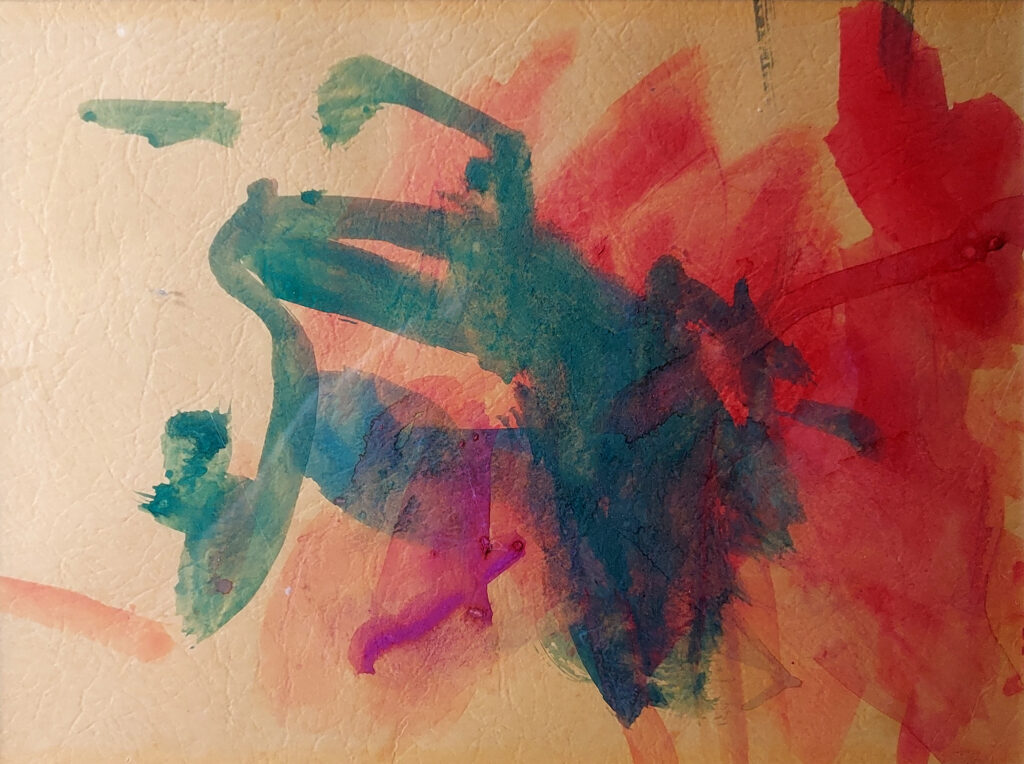
Figure 6: Watercolor by a two-year-old child
One the one hand, of course there is no objectively “right” or “wrong” answer to the question of what this painting represents, because each one’s consciousness is partially conditioned by unique karmic factors. Thus, just as in a Rorschach test, each beholder perceives exactly what he or she projected there. But on the other hand (or better, the “no-hand” that Buddhists clap with), “normal” reality as perceived by mundane consciousness is itself a colossal Rorschach test, writ infinitely large. Only when restlessly delusive mind ceases projecting its own mental formations into perceptual fields, do we see (or hear or taste or touch or smell or live or breath) what was actually intended by the creator of the art.
If Figure 6 suggests to you a frog, then you align with those who perceived the child’s actual intentions that impelled the image. The two-year-old who painted it had frequently awakened during the night, complaining of persistent “bad dreams” about frogs. After he painted it, the nightmares ceased and never returned.13
Art heals when it liberates us. From what? Dr. Gindi characterizes our primordial condition as being “trapped” in ordinary consciousness, and appeals once again to our potential fluidity of being as a way of transcending limitations imposed by mortality and finitude, stepping beyond ourselves to merge with the infinite.14 The transition is from mundane to cosmic consciousness.
Dr. Gindi also ventures beyond the expression and sublimation of primal emotions, into a noetic realm that infuses her creativity with profound metaphysical and existential questions, which her sculptures both ask and answer. Like everyone who encounters Plato, she finds grounds for both accord and dispute. His theory of forms inevitably provokes objections from aesthetic subjectivists, with whom Dr. Gindi identifies.15 Although her rejection of Platonic essences inclines her toward existentialism, neither does she fall into the trap of Sartrean solipsism.
Her artistic journey is thus evocative of Johann Wolfgang von Goethe, who was likewise schooled in both arts and sciences, and who also rebelled at the hyperbolic rationalism that had reached a zenith with Kant. Goethe and his contemporaries (notably Hamann and Schiller) immersed themselves for a time in the proto-Romantic movement of Sturm und Drang until, equally disenchanted with the emotivist extreme as with its rationalist counterpart, they found a synthesis in Weimar Classicism. Dr. Gindi expresses her own philosophical synthesis, a kind of neo-Weimar Classicism, by probing deep mysteries arising from our very existence, such as dilemmas of free will versus determinism, and “the human question of origin and destiny.”16
One such sculpture, which has caused a stir at exhibitions around Europe, is called “Fateful Choice.” Author and journalist Nick Kipley described this piece as “a phenomenological exegesis of the emotional abysses we traverse and how the harmonious paradox between the formlessness of kneaded clay and the Apollonian perpetuity of cast bronze can sublimate our will to act, or not act, into something divine.”17 Dr. Gindi’s characterization parallels his interpretation: “Submitting to fate and having a feeling of resignation can often be the norm, but if we manage to metamorphose these attitudes, we will be able to model the infinity of our existence.”18


Indeed, the artist is preoccupied with infinite possibility as an antidote to immutable fate and, more unusually from a Western perspective, she challenges our received conceptions of beginnings and endings, from the very cosmos itself to each and every spark of life that arises and evanesces within its immeasurable precincts. Many of her works reflect this fluidity as a leitmotif, not only repudiating the merciless inflexibility of a permanently frozen instant, but also approaching the Daoist ideal of the perfect sculpture as an “Uncarved Block” –that which contains all possible sculptures.

Figure 9: Dr Gindi, Immanent Conception of Infinity (2021, fired clay). Courtesy: the artist.
One such work is titled “Immanent Conception of Infinity”. While literally representing a curva- ceous female form, it figuratively suggests a hyperspherical universe, whose surface curves back on itself. Topologically, it reminds one of a Möbius strip or a Klein bottle: a non-orientable surface on which vectors cannot be consistently defined. Thus the infinite is also the ineffable.
Another poignant theme that Dr. Gindi’s work addresses is the notion of “brokenness”. The human world is rife with breakage: broken selves, broken spirits, broken relationships, and broken societies. In recent decades, we have inflicted considerable and possibly irreparable breakage on the environment itself. Individually and collectively, we all too often excel in the role of bulls in our own china shops. While medical arts and sciences can abet the setting and healing of broken bones, who are the equivalent healers of broken souls?
As Dr. Gindi notes, many pathways can be conducive to such healing, be they ancient ones walked by religion and philosophy, or modern ones like psychoanalysis.20 But her work celebrates and enshrines artistic practice as an efficacious path that likewise leads to the cure of broken souls. She explores this path in a series called “Finding Ways,”21 epitomized by a work entitled “Sancta’s Broken Halo.”

Figure 10: Dr Gindi, Sancta’s Broken Halo. 58 x 46 x 34 cm – Bronze 2021. Courtesy the artist.
This bronze encourages us to accept and embrace our imperfections, rather than denying or concealing them. As Dr. Gindi explains:
The golden patina of the bust emits a brightness echoed in the confidence of her forward-looking gaze. This brilliance further emanates from the aureole encircling her head like a crown, its cracks evoking the fractures that she has faced and overcome by revealing her vulnerability rather than repressing it. Our wounds and scars thus might be envisioned as badges of courage or medals of honor embellishing instead of marring the images we project of ourselves, which too often conform to an unrealistic ideal that is always shifting and beyond reach.22
Dr. Gindi further likens this theme to the centuries-old Japanese practice of Kintsugi, the art of restoring broken pottery by re-bonding the shards with lacquer mixed with powdered gold. Not only does this technique eschew attempts to conceal breakages; on the contrary, it both repairs yet also highlights the “fault lines”, transforming them from unsightly scars into unique if irregular facets of gleaming loveliness. Kintsugi relates to the comprehensive Japanese aesthetic of Wabi-Sabi, the notion that artistic beauty is to be found in imperfection itself.23 Indeed, even though Francis Bacon has been justly characterized as the architect of man’s misguided mission to subjugate nature, he also expressed an insight that parallels Wabi-Sabi, mirroring much of what we have seen in Dr. Gindi’s oeuvre: “There is no excellent beauty that hath not some strangeness in the proportion.”24

Figure 11: Kintsugi, https://commons.wikimedia.org/wiki/User:Haragayato
Kintsugi has discernible philosophical roots in Japan’s Nichiren Buddhism, which emphasizes teachings from the Lotus Sutra, including the all-important transformation of “poison into medicine.”25 The guiding idea is that whenever we experience circumstances that seem inimical or even toxic to our sense of well-being, we can regard them as opportunities for positive change if not enlightenment. This teaching impelled Nagarjuna to liken the Lotus Sutra allegorically to “a great physician”.26 And as Dr. Gindi observes: “People’s lives fall apart. Sancta’s Broken Halo radiates resilience, donning the fissured nimbus as a source of pride rather than sorrow and conveying a process of healing through repair and metamorphosis.”27
In sum, what makes Dr. Gindi’s art so compelling is that it represents much more than the externalization of internalized lived experience. Her sculptures not only speak to us, but moreover and more importantly dialogue with us. In her own words, “Sancta also seems to be addressing us, inviting us to follow in her footsteps by relying on our inner compass to guide us as we forge the way to an expansive experience of the self.”28 If this be art that philosophizes, then Dr. Gindi’s sculptures are also her avatars. She is clearly a philosophical practitioner, both in the flesh and also via the bronze.
To see and read more about Dr. Gindi, visit https://www.dr-gindi.com
Notes:
1. https://www.timebulletin.com/artworks-should-not-be-created-for-museums-alone-but-rath- er-for-the-profound-interest-of-the-people-says-dr-gindi-a-renowned-contemporary-sculptor/
2. https://theoverview.art/sculptor-dr-gindi-we-are-all-part-of-nature/
3. Ralph Waldo Emerson, “Nature and Other Essays”, p.31, Courier Corporation.
4. https://art-vista.com/dr-gindi-on-nature-infinity-and-descartes/
5. See e.g. Carolyn Merchant, “The Violence of Impediments: Francis Bacon and the Origins of Experimentation” Isis, 2008, 99:731–760.
6. Antonio Damasio, Descartes’ Error: Emotion, Reason, and the Human Brain, NY: Putnam, 1994. 7. Navanwita Sachdev (2022). “I float, because I float: A Conversation with Dr Gindi,” Figure- Ground.org, March, 2022. http://figureground.org/a-conversation-with-dr-gindi/
8. https://theoverview.art/sculptor-dr-gindi-we-are-all-part-of-nature/
9. E.g. see Jane Goodall, In the Shadow of Man, Boston & New York: Mariner Books, 50th Anniver- sary of Gombe edition (April 7, 2010).
10. https://www.contemporaryartissue.com/an-interview-with-dr-gindi-sculpting-fractured-reali- ty/
11. Ibid.
12. Ibid.
13. Private and confidential communication from the child’s parent.
14. ibid.
15. See Navanwita Sachdev (2022).
16. https://artstyle-editions.org/2021/09/01/between-symbolic-and-rational-thinking-the-art-of- dr-gindi/
17. https://sociable.co/entertainment/pensive-bronze-in-barcelona-captures-the-multiplici- ty-of-a-frozen-instant/
18. Ibid.
19. Lao Tzu, Tao De Jing, trans. Ch’u Ta-Kao, London: Geroge Allen & Unwin Ltd., 5th edition, 1959, verse 28. See also Lou Marinoff, The Power of Dao, Cardiff, CA: Waterside Press, 2017, chap- ter 4.
20. https://art-vista.com/the-winding-way-to-finding-our-true-selves/
21. Ibid.
22. Ibid.
23. E.g. Leonard Koren, Wabi-Sabi: for Artists, Designers, Poets & Philosophers, Point Reyes, CA: Imperfect Publishing, 1994 & 2008.
24. Francis Bacon, Essays, Civil and Moral, The Harvard Classics. 1909–14. Essay XLIII, Of Beauty. New York: P.F. Collier & Son, 1909–1917. New York: Bartleby.com, 2001.
25. E.g. https://sgibuddhism.net/forum/topics/1974950:Topic:35157
26. E.g. http://www.buddhastate.com/2012/06/turning-poison-into-medicine/
27. https://art-vista.com/the-winding-way-to-finding-our-true-selves/
28. Ibi
Lou Marinoff, Ph.D., a Commonwealth Scholar originally from Canada, is a Professor of Philosophy and of Asian Studies at The City College of New York. He is founding President of the American Philosophical Practitioners Association (APPA), and founding Editor of APPA’s Journal, Philosophical Practice. Lou has authored several international bestsellers—including Plato Not Prozac, Therapy for the Sane, The Middle Way, The Power of Dao—that apply philosophy to the resolution of everyday problems. He has also published more than sixty-five book chapters and scholarly articles. Lou’s latest books are On Human Conflict: The Philosophical Foundations of War and Peace(Rowman & Littlefield 2019), Fernando: Beethoven of the Guitar (Waterside Productions 2021), and Essays on Philosophy, Praxis and Culture (in the press, Anthem 2022).
Correspondence: lou.marinoff@appa.edu

